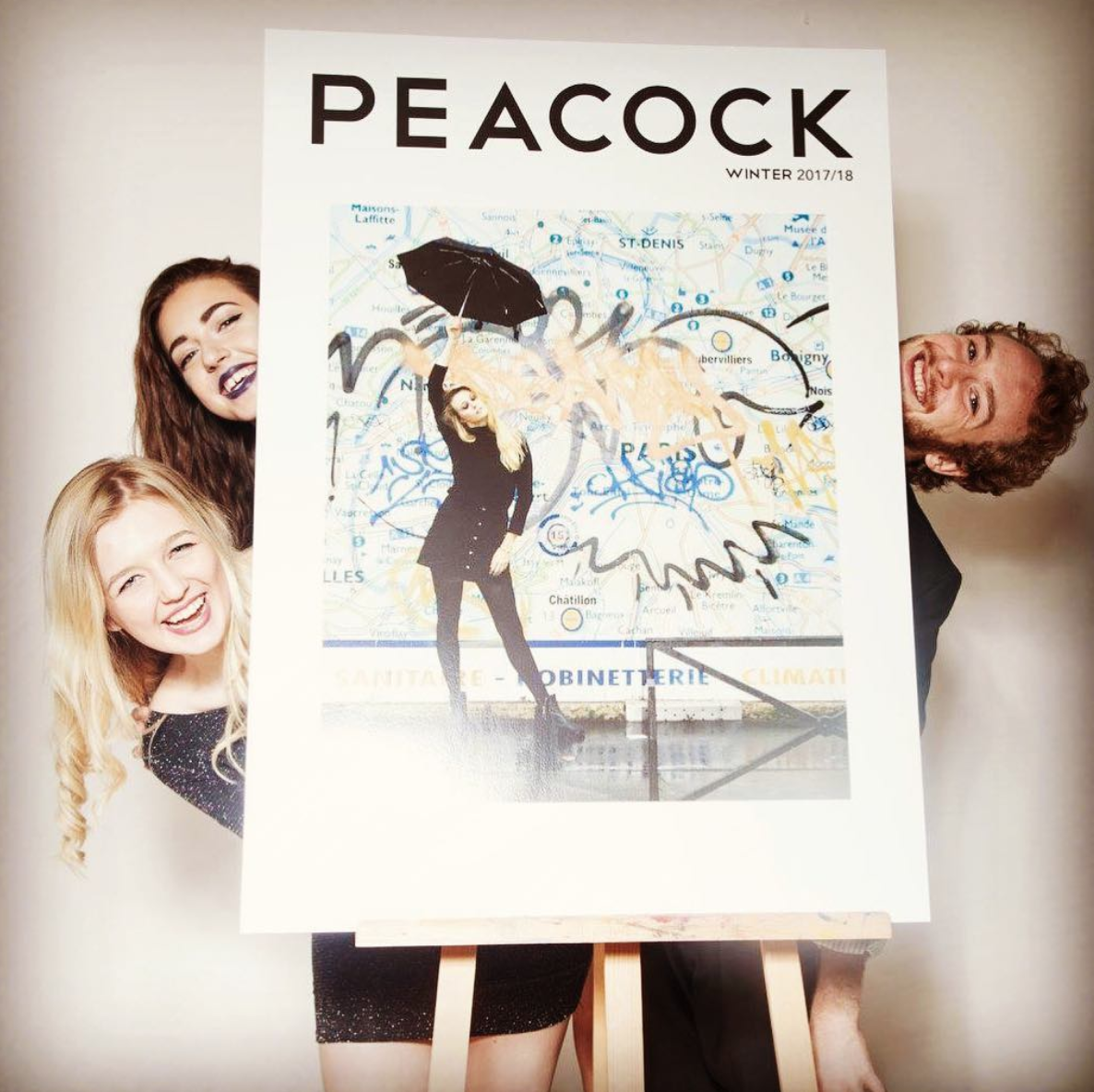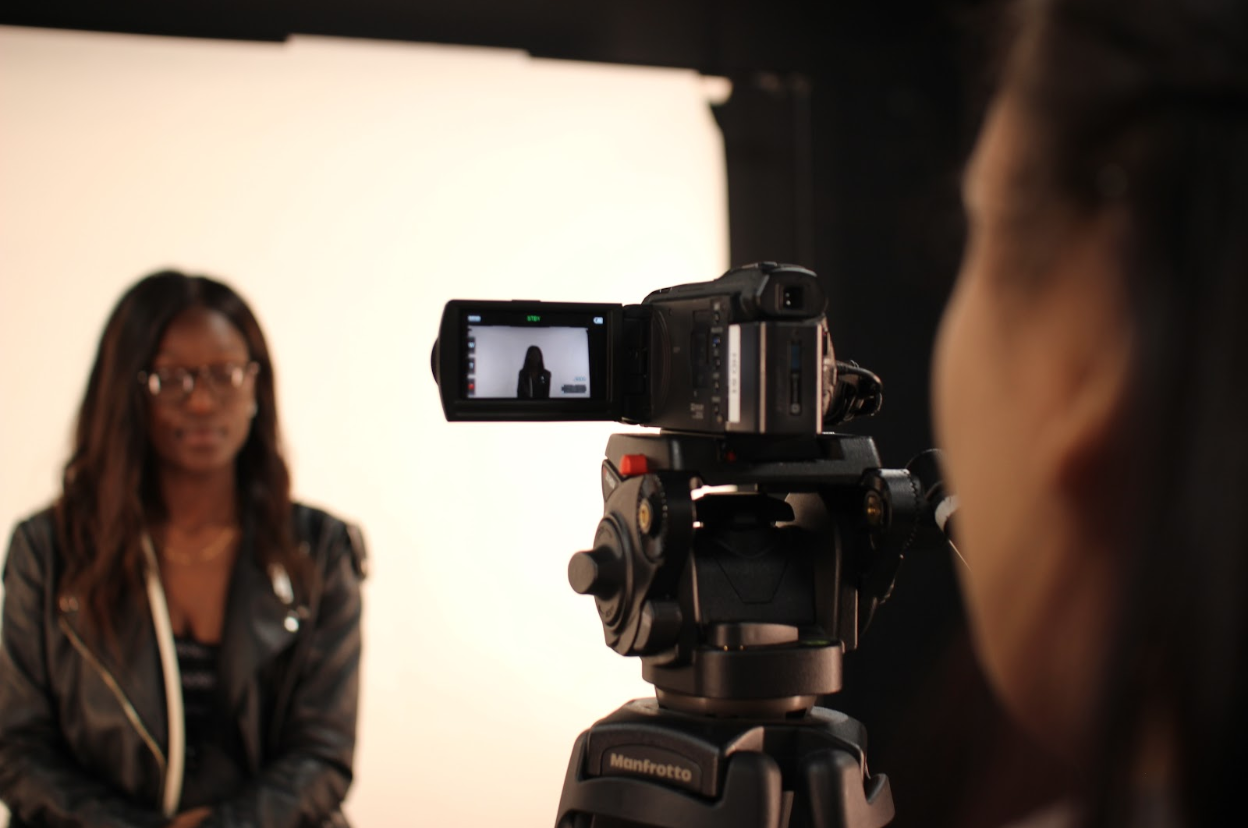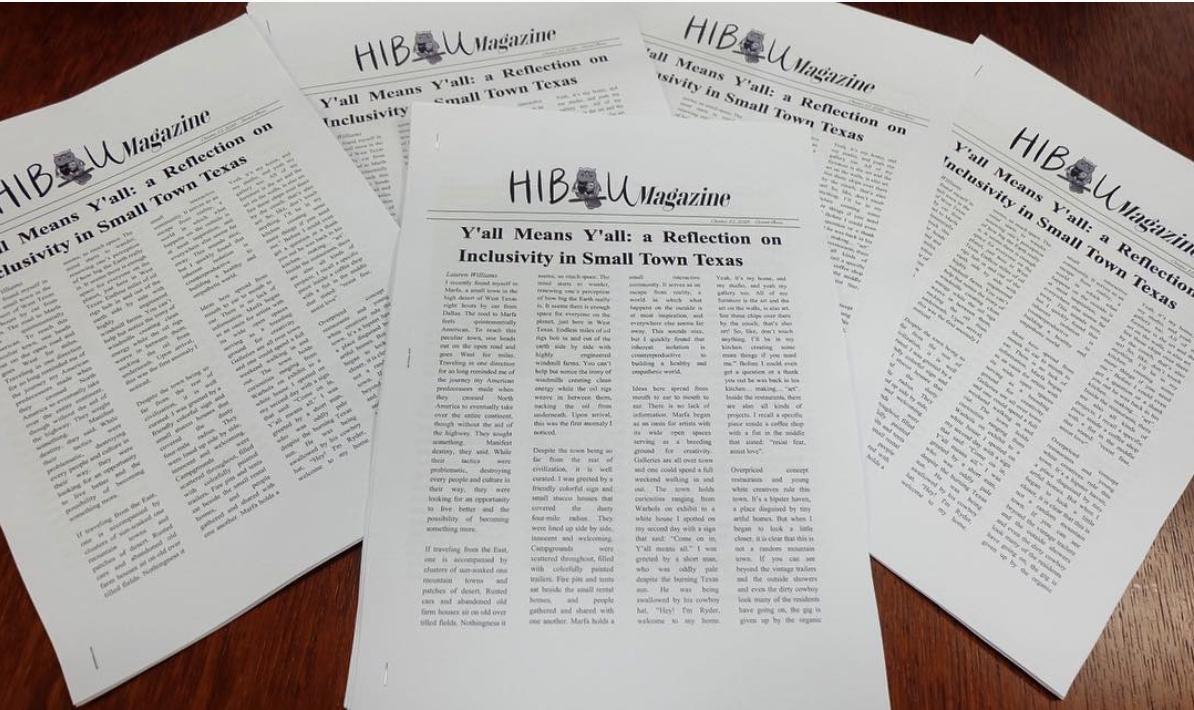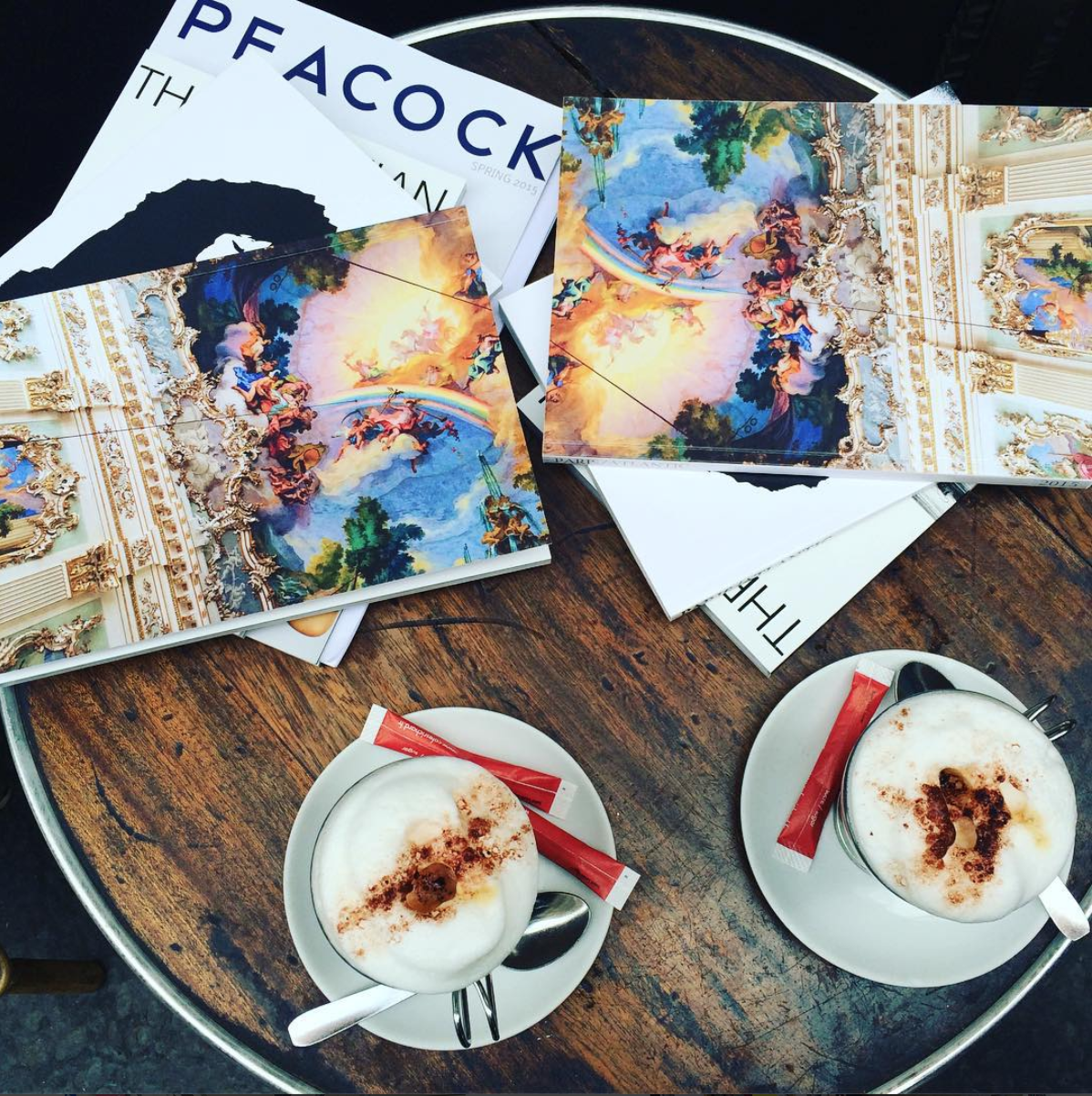AUP Student Media
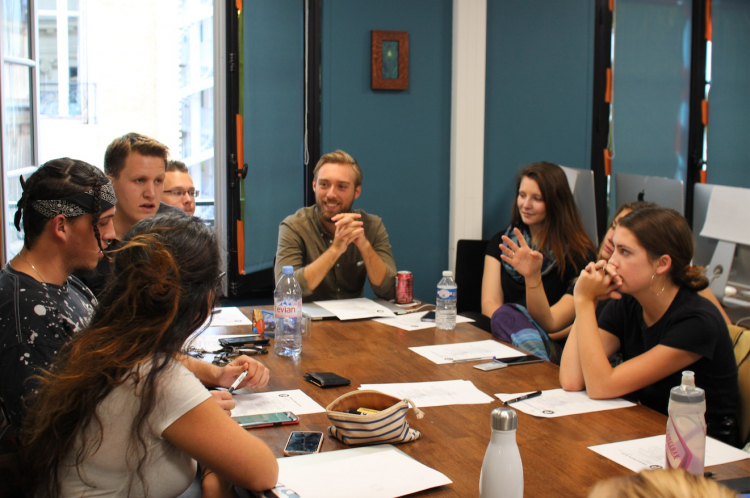
The multimedia room is filled with students waiting for weekly ASM board meeting to begin. The workload of this collective group of leaders at the American University of Paris surpasses that of the average student. As the fifth week of the semester comes to a close, the editors bond over their fatigue and the pressure to meet deadlines.
Eight of the elected student editors surround the long wooden table in the teal painted media room. Paper copies of the meeting's agenda are laid out before them. Some sheets are scribbled with annotations. The weight of leadership can be felt throughout the room. These students have chosen to not only contribute to student media but also to lead and guide contributors to create professional content for their platforms.
Masters students Madelaine VanDerHeyden, Jessica Voorhees and Savannah Rowe were elected to run the board. The trio are mentors who support marketing, social media, events, budgets and assists with managing content. Together they steer the meeting, take minutes and strategize with the undergraduate editors for the coming weeks.
The chatter amongst the students goes quiet as the meeting starts and the editors begin to share the progress and hurdles of their story lineups on their respective platforms.
Forrest Crellin, editor-in-chief of the Peacock Plume, shares his enthusiasm for the upcoming political articles developed by several student writers. The editors praise each other and provide commentary along with constructive criticism of various pieces that have been published over the past week. Editors share their accomplishments as well as the frustration of pushing students to submit their work on time. VanDerHeyden shares that the article about Macron’s presidency as the top viewed article for the week, according to website analytics.
As the brainstorming session continues, Professor Hannah Westley is seated comfortably in an armchair, in a corner of the teal room. She allows the students to take the lead and chimes in with logistical solutions to their questions, respecting the AUP Student Media mantra of "faculty advised, student-led".
“The very first board meetings had only four or five students there, it was very small compared to what you see now,” said Matthew Fraser, a Global Communications professor who worked on the original design and launch of AUP’s journalism program.
Image Credit: Alyssa BeltonThis is a contrast to the ambiance at today’s meeting. AUP Student Media, known as ASM, is a student-led organization that allows students to produce professional level content to share with the world. ASM is comprised of three platforms: Peacock Plume, Peacock Magazine and Peacock Play.
ASM has been a part of AUP since the early 70s but only in recent years has it grown into what it is today. Kevin Fore, Dean of Student Affairs, has each edition of the Peacock magazine nestled safely in his office. He has seen the many transformations of ASM and has been involved every step of the way. Fore has been apart of the AUP family for 15 years and a well-known figure on campus who regularly receives joyous greetings from students as he navigates the halls.
At the time of Fore’s arrival, the student media outlets included a newspaper, radio station and 12 scholarly journals. AUP’s journals were a part of ASM at the time. The journals were a collection of essays which were printed on a yearly basis. These dozen journals have since been reduced to two, The Lutetian and the Paris Atlantic. The Paris Atlantic is AUP’s creative arts scholarly journal.
“Each of these projects (journals) were happening outside the classroom with some limited faculty supervision. It was all outside on the student’s own time. No payment, no credit, nothing, just purely driven by student motivation,” Fore said.
Due to lack of attention and overproduction, the editors then sat down with academic affairs which reviewed the journal process and consolidated the bunch into two. This cut down the printing costs and also allowed the students working on the journal to have proper support from faculty.
“We were spending over 50,000 euros to print boxes and boxes of journals that would then sit in boxes. Some were excellent quality and some were mediocre but it didn't make a difference one way or the other because there was just too much,” Fore explained.
In 2013, a year after this change, both the Lutetian and Paris Atlantic removed themselves from the ASM board. The journals felt too dissimilar to operate under the ASM umbrella and opted for a more autonomous existence.
“They didn't want to be a part of the student media board because they felt like it was apples and oranges. There were discussions about journalism and the latest story line-ups in digital media and then, on the other hand, you had academic journals,” Fore said about the split. After the journals’ departure, ASM was condensed to the online forum and the magazine.
The need for students to express their thoughts and share their hyper-local perspective has been ever present. Both Fore and Fraser made moves to use student interest in journalism and mold a foundation for ASM and its workshops due to increased demand. Kevin Fore recalls having previous editors at his office in tears because the students did not feel supported by staff and their work was rarely seen. This sparked the idea of creating workshops for students to receive credit, mentorship, and work with their peers.
Image Credit: Alyssa BeltonFraser, a vocal but jovial professor and ex-Editor in Chief of the National Post newspaper in Canada, played a key role in the launching of the Journalism degree in 2014. After ASM’s initial launch, he added other hands-on courses — Fashion Journalism, Scripts for Travel and Feature & Investigative Journalism — to the degree. “We created new courses and we took courses that already existed and brought them in,” said Fraser.
The Journalism degree’s growth has been spectacular. It counted only 7 majors at the end of its first year, but today has about 35 majors. The soaring number of Journalism majors has had a significant impact on the growth of ASM.
Students looking to flex their journalistic muscles may consider adding the Online News course to next semester's schedule. The Online News workshop is taught by the head of journalism, Hannah Westley, and led by student editor in chief Forrest Crellin and deputy editor Fernanda Sapiña Perez. During this workshop, students learn how to create and structure professional articles that will appear on the Peacock Plume website. Hannah Westley, the faculty advisor, is pleased with the direction of all the platforms and the issues they have addressed. Westley is an advocate for giving students a platform for debate and have a forum that deals with hyperlocal concerns.
Crelin encourages all students to read the Peacock Plume to stay informed. Students taking part in the workshop can expect to consistently produce relevant news pieces on a weekly basis.
“We’ve got some bad coverage from student publications saying we’re nothing but bread and circuses. I don’t think they read the Plume. We’ve got articles on the best gelato spots in Paris and also articles on immigration processes and how it affects you, and what recent changes have been made in Macron’s government. We have a healthy dose of both bread and circuses and hard news,” Crelin said.
Image credit: Instagram @PeacockThe Peacock magazine is a tangible magazine that is published at the end of each semester. Unlike the Plume, the magazine is comprised of long-form articles centered around art, culture, fashion, politics and human interest pieces. Students seeking to write in-depth articles will feel at home with the Peacock Magazine.
What many may not know is that the magazine was started by a student in 2015. Ford Leland launched the magazine to give students a communal voice. “It wasn’t that the community was lacking an identity, it was simply lacking a method to voice it in a way that reflected the interests of its members,” wrote Leland in a letter to AUP president Celeste Schenck in 2016.
At the time, the Peacock Plume was a newspaper,The Planet, which according to Leland had “adopted a snarky, discriminatory voice that did not take itself or its readers seriously.” He recalls the publication scorning men who wore v-neck shirts, encouraging students to have unprotected sex and penultimately calling the uterus a “disgusting bloody sac”. This was the breaking point for Leland, who then recruited a 30-student team to create something new. He and his new recruits intended to create a single issue of the Peacock magazine to get students talking and attempt to reset the quality standard for publications at the University. And it did.
“The last thing I wanted was to see my university invest money in publishing articles that made fun of people like me who had come there looking for a safe place to be themselves,” said Leland.
Leland, 28, today owns his own branding and design agency and frequently finds himself on campus at AUP. “I always pick up as many copies of the newest Peacock whenever I can. I am incredibly impressed by the quality — particularly over the last year,” he said.
Following the creation of the Peacock magazine, the Planet was rebranded (first as Peacock Post, then as Peacock Plume) while the magazine course was integrated into the curriculum. Today the magazine workshop is led by student editor Katerina McGrath, co-editor Leona Caanen and art director Sophia Foerster. The course has been taught by Marc Feustel since the fall of 2015. The class has evolved with the magazine industry whilst preparing students to create a complete magazine over 10 weeks. From choosing topics and photographs to distributing 1,000 copies, students leave the course with a knowledge of all aspects of creating a magazine.
“In simple terms, the Online News class produces more news content, newsworthy articles focusing on current events and issues inside and outside of AUP, while the Magazine Journalism class is less focused on newsworthiness and more on storytelling,” said Professor Feustel.
Students in this course will learn all the techniques necessary to produce long-form engaging articles to be published at the end of each semester and revealed at a launch party.
Image Credit: Alyssa BeltonMcGrath has been enjoying helping students work on their writing skills and the sense of community that has been built with the students. McGrath's role entails editing students pieces with the help of Feustel and putting together the entirety of the 80-page magazine. She has welcomed the task of curating students interests and turning it into magazine pieces, which we will soon see when the issue is unveiled.
"For the magazine this semester, you guys should be expecting some very diverse articles in terms of what the content is about. A lot of pieces are about people, nature and the relationship to our environment," said McGrath. She invites you to attend the Magazine launch party on December 14th where students and faculty can peruse the newest issue.
The ASM hydra would not be complete without Peacock Play. With the rise of Youtube culture and citizen journalism, video is vital for news and journalism as we know it today. The Peacock Play workshop is taught by Jurgen Hecker and lead by head producer Lauren Domagas and deputy producers Delton Howard and Hussam Ibrahim. Throughout this course students receive hands-on training, combining both journalism and video. They will also learn how to purposefully document news and again a full understanding of how to operate a camera.
“Some students may think it’s a lot for a two-credit course, there is a lot that we need to pack into this. The aim of this course is to come out at the end of this semester and know how to shoot, simple but solid well documented journalistic video,” said Hecker.
Malick Rupert, teaching assistant for the course has taken it 5 times over his AUP career. He is an ASM veteran who devotes his time to helping students evolve their skills and share what he has learned along the way.
Image Credit: Alyssa Belton“ASM is a really unique opportunity to get dropped in the water. There’s a lot of support to make sure that you swim. ASM gives students a really unique opportunity to become a journalist and try their best. It’s a really supportive group,” said Rupert.
Students are hard at work this semester to bring weekly videos to the Peacock Play platform. Among them is Elise Chauvel, a junior.
"I think it’s a really interesting class, I wish I got involved earlier. Its cool how students come together, pitch an idea and develop your own project via their point of view," said Chauvel.
Peacock Play recently released a video about AUP for consent which has received praise from both students and staff alike.
ASM is not the end all be all of the publications on campus. The previously mentioned Lutetian, Paris Atlantic are alive and well. Roaches, a newcomer to AUP is an inclusive zine that combines feminist, radical queer, race theory and a variety of creative activist projects. Hibou Magazine is a student-run, politically charged publication available on campus now.
Hibou, an online magazine is written by 25 writers and 4 editors, under the leadership of editor in chief Isabelle Siegel. The magazine began as the final project for the Education, Freedom Citizenship course taught by Professor Michelle Kuo in Fall 2017.
“She (Kuo) believed there was a need for diversity in journalism at AUP to hold student publications to higher standards and to help students develop as writers,” said Siegel, explaining why they started Hibou.
Image Credit: Instagram @HibouMagazineThe Hibou team aims to work in conjunction with all AUP publications to engage students, provide compelling content, meanwhile allowing individuals to voice their opinions and critiques.
Lauren Williams had the opportunity to participate in both the Peacock and Hibou magazine. "I would say the biggest difference is that you get to write more of what you want because there isn't a theme. There is more of an academic feel to it. A lot of the pieces you'll see are a little more reflective and political. You have a bit more freedom to write what you want because it isn't graded but I really enjoyed both experiences,” said Williams.
Siegel wishes to continue to work with other publications to take up more space on campus and engage students and she encourages anyone in the AUP community to join her skilled team in doing so. What is the difference between the two?
“Topically, ASM focuses on AUP events, culture, art, and fashion, as well as some current events. Hibou has some overlap, but focuses more on critical thinking and is more politically charged. In the ways we overlap, I believe we will foster a healthy competition that elevates both publications,” said Siegel.
Another difference the editor shared is that last semester Hibou magazine receive a 200-euro budget for their website from the senate and was denied a budget for print. Whereas ASM as a whole receives roughly 27,000 euros per year. This created a natural tension between the two publications that is slowly on the mend. This year the Hibou team has secured 400 euros from the senate and are delighted at the progress. Hibou hopes to receive additional funds to support their growing operation and to maintain a cordial relationship with the existing publications.
Image credit: Instagram @skylarsmileyIn response to avoiding budget issues and unifying all existing publications, Kevin Fore suggests more communication. “There's no real process for other journals who want to come about. So I think part of the discussion is to find out how do we decide what is an AUP sponsored Journal, and how do we decide what resources are allocated to those journals. Bringing those groups together so that they can be part of that conversation because right now they're all working in kind of isolated ways. And I think that maybe having them come together a couple times a year just to get the general situation will be a good thing,” said Fore in regards to the past tension and working in tandem in future.
Hannah Westley the ASM faculty advisor encourages students to join the workshops and contribute to the platform. If your schedule does not allow you to commit full time, there is a freelance submission form available to suggest stories and videos to complete in your own time.
“It (ASM) allows students to present their own unique perspective on national news, international news, and global news. While the Brett Kavanaugh case is being covered by multiple news outlets around the world, our students still have something unique to contribute to that debate,” said Westley.
In addition to the sharing of views with the AUP community, participating in any of the ASM workshops will leave students with a portfolio of work that can be used to springboard careers and make the workforce transition that much easier. These courses give participants the opportunity to not only tell employers what they can do, but also show their acquired skills through the videos and articles produced in the workshop.
If writing and video aren’t for you, the Plume has recently launched a podcast tab on their website and will be holding a masterclass led by Katerina McGrath. McGrath will give students a step by step course on how to logistically record a podcast to give students the knowledge to create their own.
ASM is open to any student and all majors and more importantly, no experience is necessary. “ASM is space where students can express their views, give their own unique perspective on the news and talk about things that matter to them,” said Hannah Westley. Join the ASM team to make your voice heard while creating content for your community. You’ll be glad you did.


